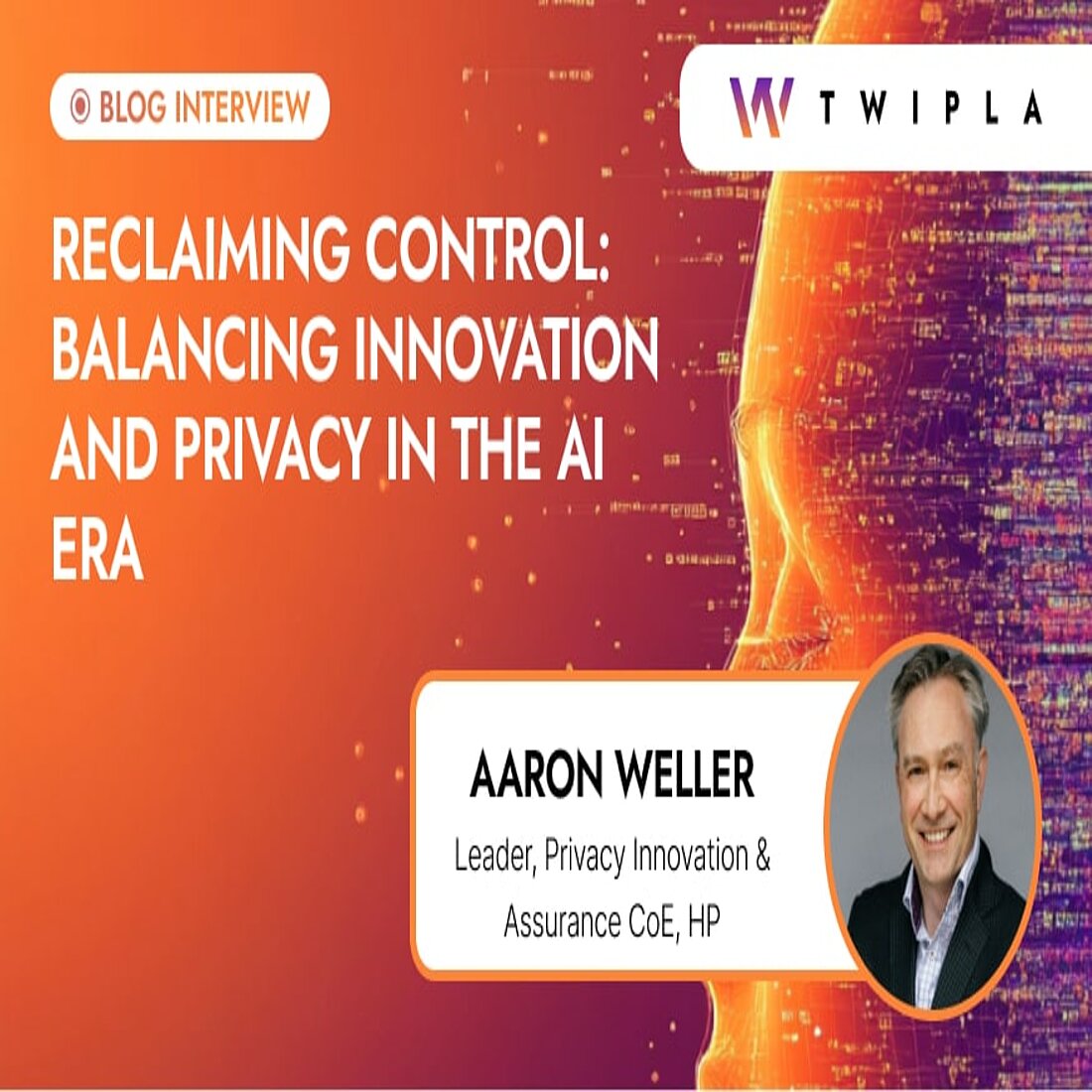- Why Us?
- Features
White Label
For SaaS Platforms & Agencies
Provide our complete analytics suite to your clients, directly within your own interface and with your/their own branding. Discover Analytics-as-a-Service and White Label Analytics. Great benefit, minimal effort.
- Pricing
- White Label
- Success Stories
- Partner
- ResourcesExpand Your Knowledge
TWIPLA Staff January 02, 2025
4 min
CONTENTS
- 1. What are the emerging privacy challenges posed by AI and advanced technologies?
- 2. What strategies help simplify privacy disclosures while ensuring compliance?
- Be specific
- Be consistent
- Provide tiered access to documents
- 3. How can businesses effectively manage the different data governance requirements?
- Start with a principles-based approach
- Set your standard at the most restrictive level
- Incorporate as many requirements as you can up front
- About Aaron Weller
1. What are the emerging privacy challenges posed by AI and advanced technologies?
What is shared by and about us from our use of technology can be unsettling. Our activities generate an enormous amount of data that contributes to multiple narratives about our lives, which are then compiled in larger data sets to create advertising for, target content to, and make predictions about us.
The more information companies can accrue, the more nuanced the picture they can create of an individual. One of the largest challenges to privacy from AI is the risk posed by the data we consider non-personal or incidental but can still contribute to an overall profile of a person. As a result, companies that only trigger privacy reviews when personal data elements are present are unknowingly opening themselves and their customers up to increased levels of risk.
AI excels at pattern recognition, which is a risk to deidentified, aggregated, and pseudonymized data. Even encrypted data can be at risk as technology advances. Leading companies are already implementing quantum-resistant encryption techniques to defend against the rise of quantum computing capabilities. Without robust, clearly defined, and regularly updated standards for aggregation, deidentification, and encryption, we run the risk of using data in express contravention of individuals preferences and may violate their rights. We also run the risk of being unable to accurately identify and locate personal data that has been reidentified or inadvertently associated with a person, which makes us unable to respond appropriately to access or accountability requests from individuals, or data authorities.
Incidental data can include data collected or contributed about a data subject unintentionally, by inference, accident, or from indirect sources. There are many data points that relate to an individual that are not direct or immediate identifiers, but that can be combined with known profiles or additional data sets to supply information about a person that they did not deliberately volunteer.
New technologies and tools can also create new avenues to capture incidental data, making previously deidentified data identifiable, or generating new insights from an old data set. In many cases, these new applications of data could not have been predicted by the data subjects at the time, raising questions about the legitimacy of reliance on the consent and collection process to truly reflect users' preferences over time.
Purpose limitation and a consent process that prioritizes respect for persons rights and preferences are key to mitigating these issues. Using information only for the purposes disclosed at the time of collection helps to reduce the risk of incidental information being used for unauthorized purposes and ensures that both the letter and the spirit of consent are being honored.
Information that has been deidentified or encrypted should not be used to contribute to individual profiling, regardless of whether emerging technologies present capabilities to do so. By reducing the risk of reidentification, we reduce the risks of being unable to comply with individual requests or regulatory audits.
2. What strategies help simplify privacy disclosures while ensuring compliance?
With the increasing complexity of data collection methodologies, transparent disclosures about data use and processing are becoming commensurately complex. To ensure that you are communicating these complex concepts in ways that are approachable and understandable, there are three key steps to creating a privacy policy or notice you can follow.
Be specific
Many regional and sectoral laws require that organizations that process data be transparent in their policies about how data are collected, used, and shared. These transparency requirements can lead to a patchwork collection of policies and processes, which can be both alienating and confounding for users to decode. For example, if you have multiple data collection interfaces, schemas and processes, these processes should be clearly distinguished to avoid confusion. Trying to distill the description of what you collect to the lowest common denominator can lead to over generalized and misleading language.
Not all users will participate in every aspect of an offered service, and these users should be able to easily and quickly determine what interactions with the service will lead to each type of data collection. This will help users make informed decisions about how they interact with the services being provided.
Be consistent
Your document should be navigable and straightforward, using internal references and hyperlinks to ensure related concepts and disclosures are associated for ease of access. Using consistent language and terms can help keep concepts organized and clear.
Terms should be clearly defined upfront, and definitions should be available for reference in a linked glossary to ensure that each document can be parsed and understood at a foundational level. Using consistent language across the documents reduces confusion and prevents the conflation of related concepts or services. You should also consider the audience(s) for these documents. Communication occurs when the message is received and understood. You want your documents to be communicated, not just made available for review.

Provide tiered access to documents
Not everything needs to make the front page. Your disclosures can increase in complexity as they increase in specificity. Allowing users to access more information in a thoughtful, stepwise manner will avoid overwhelming users up front and provide a clear and specific method for accessing further information.
Organizing these documents to provide an accessible, comprehensive experience to users seeking information is not just a courtesy, it is a strategic investment in the continued transparency of your processes and, in the value of your brand.
3. How can businesses effectively manage the different data governance requirements?
The dizzying number of requirements for the governance of data are increasing annually, making a complex landscape that can be difficult to navigate. With new standards and laws being developed to keep pace with emerging technologies, trying to keep up can feel like an endless marathon.
Here are three practices your organization can implement to improve the governance odyssey and help make the regulatory landscape more accessible.
Start with a principles-based approach
Many laws that cover data usage topics have a basis in ethics and human rights, so it follows that controls and requirements should be designed to support those rights and protections as well as supporting innovation and business strategies.
It can be helpful to create a set of guiding ethical principles to inform decision making as opposed to a framework that relies exclusively on the letter of the law - this way, your strategic thinking is influenced by a broader ethos than simple compliance.
Set your standard at the most restrictive level
If your organization operates across jurisdictions and with multiple legal frameworks, it can be confusing to implement multiple processes for different territorial sectors. The easiest thing to do is set the strictest requirements as your baseline and make exceptions based on business case and risk rather than try to find a median operating standard.
Moreover, inequitable data protections can result in imbalanced data and inaccurate, biased insights.
Incorporate as many requirements as you can up front
Laws and proposed regulations are published before coming into effect. While the timeline may vary, some jurisdictions will give you over a year to plan for compliance. During this time, allocate resources to reviewing and integrating new requirements. If you know you will need specific contract language, processes, or documentation, start to create them proactively. Map new controls to existing frameworks for example, many ISO standards are written to build upon one another, so evolving your compliance program should be easy with the appropriate foundation.
Aaron Weller is a seasoned privacy expert with over 25 years of international experience in information security and privacy. As the leader of HP's Privacy Innovation and Assurance Center of Excellence, Aaron drives innovative strategies to help organizations ethically manage and leverage personal data for business success.
A recognized thought leader, Aaron co-founded a consulting and technology company after leading PwC's Privacy practice in the west of the United States. His expertise spans privacy engineering, AI governance, and strategic consulting, earning him the prestigious Fellow of Information Privacy (FIP) designation from the IAPP.
Aaron's insights have been featured in publications like the Wall Street Journal, and he has contributed to key privacy standards such as ISO31700 – Privacy by Design for Consumer Products & Services. He regularly shares his expertise at conferences and as a guest lecturer at the University of Washington.
Share article
Get Started for Free
Gain World-Class Insights & Offer Innovative Privacy & Security

You might also like
2025 Marketing Compliance: Your Ultimate Guide (including Checklist) 19 December 2024 - by Simon Coulthard
19 December 2024 - by Simon Coulthard











